Performance Characteristics of Silicone Rubber for Use in Acidic Environments
Abstract
:1. Introduction
2. Materials and Methods
2.1. Experimental Samples
2.2. Experimental Method
- Electrical characteristics test: In this paper, the specimen is tested in the Chongqing University high-voltage laboratory for the I.F. dry flashover test and the I.F. pollution flashover test, and the test voltage is provided by the YDTW-100kVA/100kV AC transformer (from China Yangzhou Xinyuan Electricity Co., Yangzhou, China) to meet the test requirements. Figure 2 shows the electrode arrangement of the flashover voltage test, and Figure 3 shows the wiring schematic of the flashover test. During the test, the silicone rubber is placed horizontally, the high-voltage electrode is connected to the high-voltage end of the power supply through the protective resistor, the grounding electrode is directly grounded, and the flashover voltage is recorded through the capacitive voltage divider.Before the flash test is conducted, the test article needs to be pretreated. The new test product will be cleaned as thoroughly as possible with anhydrous ethanol, and then rinsed with a large amount of distilled water and dried for 24 h. Before the pollution flashover test, the new test product will be manually coated with dirt, so that the salt density and gray density of the surface are the same as the test product after one year of aging. The dry flashover and pollution flashover voltages of the silicone rubber specimens were measured by the uniform step-up method according to IEC 60060-1:2010 for insulators and the flashover voltage test method [22]. In order to ensure the accuracy and reliability of the flashover voltage data, and to eliminate the influence of chance, three specimens were taken for each sample, and three to five repetitions of the test were performed for each specimen. Take the average value of 9 voltages with the average error of not more than 10% and the relative deviation of not more than 5% as the average flash voltage of the test product. The average flashover voltage and the relative deviation are calculated as follows:where m is the number of repeated tests (m = 9), Uf is the average flashover voltage, and σ% is the relative deviation.
- Hydrophobicity test: The spray method is a method to initially classify the hydrophobicity of a material into 6 grades by spraying water on the surface and observing the state of the water droplets, with reference to IEC/TA 62073 and STRI Guide [23,24], and the hydrophobicity grade from 1 to 6 is gradually reduced. The static contact angle method: The optical-contact-angle measuring instrument commonly used to test the static contact angle is not applicable in this paper. This is due to the fact that the static contact angle measurement is required once before and after the pollution flashover test for the test article after one year of aging, and the natural dirt on the test article cannot be damaged before the test, which makes it impossible to cut the test article into the specifications needed for the measuring instrument to measure. In order to complete all experiments well within the constraints of the limited test items, the following methods are used in this paper: three samples of each silicone rubber were taken, and 10 drops of water with a volume of 10 μL were placed on each sample and photographed with a high-resolution camera; finally, the static contact angle θ of each water droplet was obtained by processing the photos with MATLAB, and the average value was recorded as the θav of the sample.
- Scanning electron microscope (SEM): In this paper, the specimens were scanned by an environmental scanning electron microscope manufactured by Thermo Fisher, MA, USA, to investigate the microstructural differences. Due to the extremely poor electrical conductivity of the silicone rubber material, the specimens needed to be sprayed with 60 s gold before scanning.
- Fourier transform infrared spectroscopy (FTIR): A Nicolet iS50 Fourier transform infrared spectrometer from Thermo Fisher, MA, USA, was used to measure the infrared spectra of the specimens, and the test range of the equipment was from 400 to 4000 cm−1.
- X-ray energy-dispersive spectrometer: An ESCALAB 250Xi multifunctional X-ray photoelectron spectrometer from Thermo Fisher, MA, USA, was used to perform the X-ray spectroscopy on the flake specimens.
- Dielectric parameters: In this paper, we used the Alpha-Aconcept 80 broadband dielectric spectrum analyzer from Novecontrol Technologies, Montabaur (Germany), and the Agilent high-frequency analyzer to measure the dielectric parameters of specimens in the frequency range of 3 μHz to 40 MHz.
3. Results
3.1. Surface Condition
3.2. Dry Flashover Voltage
3.3. Hydrophobicity
3.4. Pollution Flashover Voltage
4. Discussion and Analysis
4.1. SEM Analysis
4.2. FTIR Analysis
- The main peaks of FTIR spectra of the silicone rubber sheets of different models and aging years remained basically the same; no new peaks were generated, the original peaks disappeared, and the corresponding bands of the peaks were not displaced, indicating that the chemical bonding composition of the silicone rubber surface remained basically the same, and no increase or decrease occurred;
- The intensity of the Si−(CH3)2 absorption peaks located in the 840~790 cm−1 band from top to bottom are new silicone rubber of two types, common silicone rubber aged for one year and acid-resistant silicone rubber aged for one year, which are consistent with the performance results of the water-repellency test of the specimen. The Si−O−Si absorption peaks of the new silicone rubber sheet and the silicone rubber sheet aged for one year in the band of 1100~1000 cm−1 are basically the same, which indicates that the two types of silicone rubber sheets aged for one year have the same performance of keeping silicon small molecules from migrating and being lost. The C−H absorption peaks in the bands of 840−790 cm−1, 1270−1255 cm−1, and 2960 cm−1 also showed a significant simultaneous decrease. The decrease in the C−H bond content was mainly due to the fracture of the −CH3 functional groups in the silicone rubber;
- The O−H bonds of the four test grades in the 3700~3200 cm−1 band showed obvious stratification, from top to bottom; they were the new acid-resistant silicone rubber, new common silicone rubber, aged-one-year acid-resistant silicone rubber, and aged-one-year common silicone rubber, indicating that the number of O−H bonds of the new acid-resistant silicone rubber was larger than that of the common type, which is consistent with the static contact angle. That is, the −OH content is high when the static contact angle is large. The intensity of the absorption peak of the O−H bonds decreased with the increase in the aging of the silicone rubber. Therefore, the large number of O−H bonds on the surface of the acid-resistant silicone rubber will help to delay the aging of the silicone rubber.
4.3. X-ray Energy-Dispersive Spectrometer Analysis
- The surface oxygen element content of the new acid-resistant silicone rubber is higher than that of the common type. This is due to the presence of a large number of O−H bonds in the coating present on the surface of the acid-resistant silicone rubber, as evidenced by FTIR tests, while the content of both carbon and silicon elements is basically the same;
- After one year of natural aging, the small silicone molecules in the silicone rubber (carbon and silicon elements are mainly silicone molecules) begin to migrate to the surface of the fouling layer, resulting in the carbon and silicon content of the silicone rubber beginning to fall, while the content of inorganic flame retardants (Al(OH)3) in the material remains unchanged, leading to a rise in the relative content of oxygen elements;
- Acid-resistant silicone rubber has a better ability to resist oxidation and to keep small silicone molecules from migrating than the common silicone rubber.
4.4. Dielectric Parameters Analysis
5. Conclusions
- (1)
- The dry flashover voltage and pollution flashover voltage of the acid-resistant silicone rubber are greatly improved compared to those of the common-type silicone rubber, while the acid-resistant silicone rubber’s resistance to dirt and aging is also stronger. In terms of hydrophobicity, the acid-resistant silicone rubber also shows better performance, but due to the short aging time, both types of silicone rubber specimens show good hydrophobicity;
- (2)
- From the results of the SEM, in the preaging period, the chemical degradation of common-type silicone rubber had not yet penetrated into the interior of the silicone rubber, and only produced tiny debris at the surface; whereas the acid-resistant silicone rubber had the surface of the coating oxidize first, which protected the silicone rubber body, and this phenomenon also created an acid-resistant silicone rubber with a stronger hydrophobicity;
- (3)
- The results of the three methods of the FTIR, X-ray energy-spectrum analysis, and dielectric parameter testing on the silicone rubber were all consistent with the results of the electrical property testing and SEM, verifying the ability of the acid-resistant silicone rubber to retard aging in terms of microscopic characteristics;
- (4)
- Considering the growth of aging time, common-type silicone rubber is not protected by an acid-resistant coating, resulting in a faster surface-oxidation speed in an acidic environment, leading to acidic large cracks and resulting in holes, rough protrusions, and a substantial degradation of performance;
- (5)
- The study in this paper has some objective limitations. The aging time of the samples in the natural environment was only one year, and future studies need to observe their performance in longer time scales, as well as the performance characteristics of alkali-resistant silicone rubber in alkaline environments.
Author Contributions
Funding
Institutional Review Board Statement
Informed Consent Statement
Data Availability Statement
Conflicts of Interest
References
- Cherney, E.A.; Gorur, R.S. RTV silicone rubber coatings for outdoor insulators. Dielectr. Electr. Insul. IEEE Trans. 1999, 6, 605–611. [Google Scholar] [CrossRef]
- Zhang, D.; Xu, H.; Huang, X.; Zhang, Z.; Jiang, X. Space Electric Field Characteristics of Silicone Rubber Insulator Pollution Flashover and Its Application in Flashover Prewarning. IEEE Trans. Dielectr. Electr. Insul. 2023, 30, 439–448. [Google Scholar] [CrossRef]
- Khan, H.; Amin, M.; Ahmad, A. Characteristics of silicone composites for high voltage insulations. Rev. Adv. Mater. Sci. 2018, 56, 91–123. [Google Scholar] [CrossRef]
- Papailiou, K.O.; Schmuck, F. Material selection and manufacturing processes for composite insulators with silicone rubber housing. Power Syst. 2013, 75, 197–283. [Google Scholar]
- Gorur, R.S.; Karady, G.G. Aging in silicone rubber for outdoor insulation. IEEE Trans. Power Deliv. 1992, 7, 525–538. [Google Scholar] [CrossRef]
- Gutman, I.; Wieck, H.; Dan, W.; Stenström, L.; Dan, G. Pollution Measurements to Assess the Performance of Naturally Exposed Silicone Rubber Composite Insulators. IEEJ Trans. Fundam. Mater. 2007, 127, 513–518. [Google Scholar] [CrossRef]
- Ahmadi-Joneidi, I.; Majzoobi, A.; Shayegani-Akmal, A.A.; Mohseni, H. Aging evaluation of silicone rubber insulators using leakage current and flashover voltage analysis. IEEE Trans. Dielectr. Electr. Insul. 2013, 20, 212–220. [Google Scholar] [CrossRef]
- Xu, Z.; Cheng, J.; Wu, J.; He, W. Non-destructive aging detection method for silicone rubber insulator shed based on unilateral nmr principle. Proc. Chin. Soc. Electr. Eng. 2014, 34, 6545–6553. [Google Scholar]
- Xu, Z.; Ye, Q. Optimal Design of a Portable Arc-Shaped NMR Sensor and Its Application in the Aging-Level Detection of Silicone Rubber Insulator. Appl. Magn. Reson. 2016, 47, 175–189. [Google Scholar]
- Qiao, X.; Zhang, Z.; Jiang, X. A New Evaluation Method of Aging Properties for Silicon Rubber Material Based on Microscopic Images. IEEE Access 2019, 7, 15162–15169. [Google Scholar] [CrossRef]
- Jiang, H.; Li, B.; Zhao, B.; Sun, Q.; Chen, B. Photothermal Radiometry Depth-profiling of Aged Silicon Rubber Composite Insulators. IEEE Trans. Power Deliv. 2020, 36, 3223–3230. [Google Scholar] [CrossRef]
- Jiang, H.; Li, B.; Zhao, B.; Wang, Y. Aging characterization of 500-kV field-serviced silicone rubber composite insulators with self-normalized photothermal radiometry. Infrared Phys. Technol. 2021, 116, 103763. [Google Scholar] [CrossRef]
- Ahmed, R.; Rahman, R.A.; Jamal, A.; Salem, A.A.; Saman, B.; Lau, K.Y.; Ghoneim, S.S.M. Field-Dependent Pollution Model under Polluted Environments for Outdoor Polymeric Insulators. Polymers 2021, 14, 516. [Google Scholar] [CrossRef]
- Ahmed, R.; Kim, T.; Lee, Y.J.; Jeon, S.; Yi, J.; Choi, I.H.; Son, J.A.; Koo, J.B. Online Condition Monitoring and Leakage Current Effect Based on Local Area Environment. Trans. Electr. Electron. Mater. 2020, 21, 144–149. [Google Scholar] [CrossRef]
- Li, C.; Zhao, L.; Xiong, J.; Zhang, S. Influence of seasons on hydrophobicity of silicone rubber insulators in semi-wet warm-temperature zone of china. IEEE Trans. Dielectr. Electr. Insul. 2008, 15, 1081–1088. [Google Scholar]
- Fernando, M.A.R.M.; Gubanski, S.M. Ageing of silicone rubber insulators in coastal and inland tropical environment. IEEE Trans. Dielectr. Electr. Insul. 2010, 17, 326–333. [Google Scholar] [CrossRef]
- Rezaei, M.; Ahmadi-Joneidi, I.; Parhizgar, A.; Kahuri, H. Evaluation of actual field ageing on silicone rubber insulator under coastal environment. Life Sci. J. 2013, 10, 199–205. [Google Scholar]
- Chakraborty, R.; Reddy, B.S. Studies on high temperature vulcanized silicone rubber insulators under arid climatic aging. IEEE Trans. Dielectr. Electr. Insul. 2017, 24, 1751–1760. [Google Scholar] [CrossRef]
- Wang, X.; Kumagai, S.; Yoshimura, N. Contamination performances of silicone rubber insulator subjected to acid rain. IEEE Trans. Dielectr. Electr. Insul. 2002, 5, 909–916. [Google Scholar] [CrossRef]
- Verma, A.R.; Reddy, B.S. Accelerated aging studies of silicon-rubber based polymeric insulators used for HV transmission lines. Polym. Test. 2017, 62, 124–131. [Google Scholar] [CrossRef]
- Lee, J.-H.; Koo, J.-Y. An Experimental Investigation on the Characteristics of the Outdoor Silicone Rubber Insulator due to Sulfuric and Nitric Solutions of Acid Rain. Trans. Korean Inst. Electr. Eng. 1998, 64, 1484–1490. [Google Scholar]
- IEC 60060-1:2010; High Voltage Test Techniques, Part I: General Test Requirements. IEC: Geneva, Switzerland, 2010.
- IEC/TS 62073: 2016; Guidance on the Measurement of Hydrophobicity of Insulator Surfaces. IEC: Geneva, Switzerland, 2016.
- Guide 1, 92/1; Hydrophobicity Classification Guide. Swedish Transmission Research Institute-STRI: Ludvika, Sweden, 1992.
- Gustavsson, T.G.; Gubanski, S.M.; Hillborg, H.; Karlsson, S.; Gedde, U.W. Aging of silicone rubber under ac or dc voltages in a coastal environment. IEEE Trans. Dielectr. Electr. Insul. 2001, 8, 1029–1039. [Google Scholar] [CrossRef]
- Verma, A.R.; Reddy, B.S. Interpretation of surface degradation on polymeric insulators. Eng. Fail. Anal. 2019, 95, 214–225. [Google Scholar] [CrossRef]
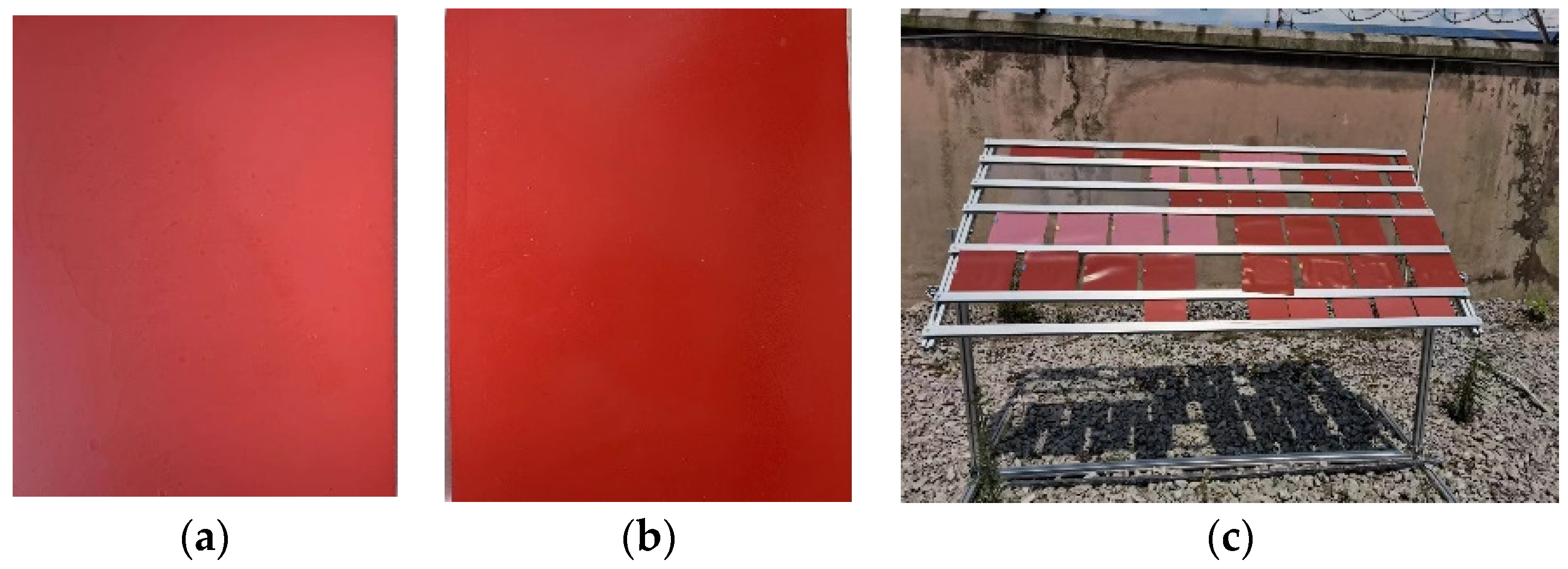
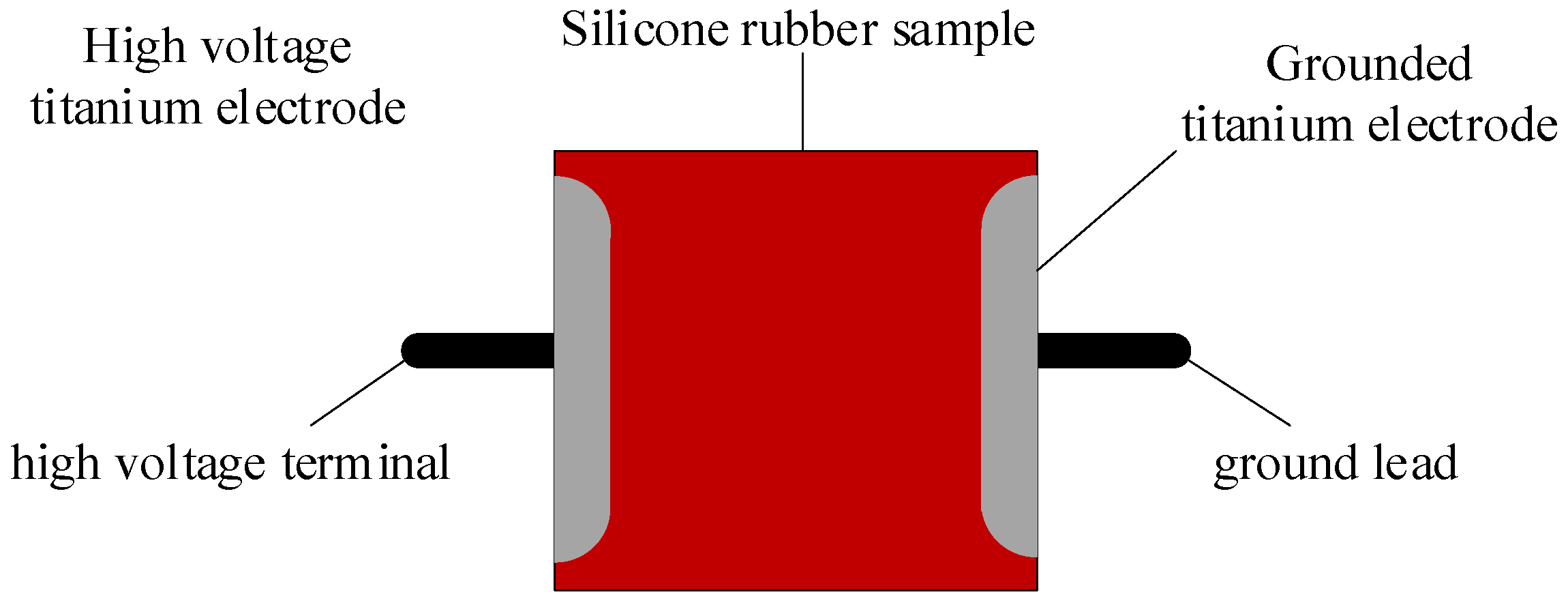
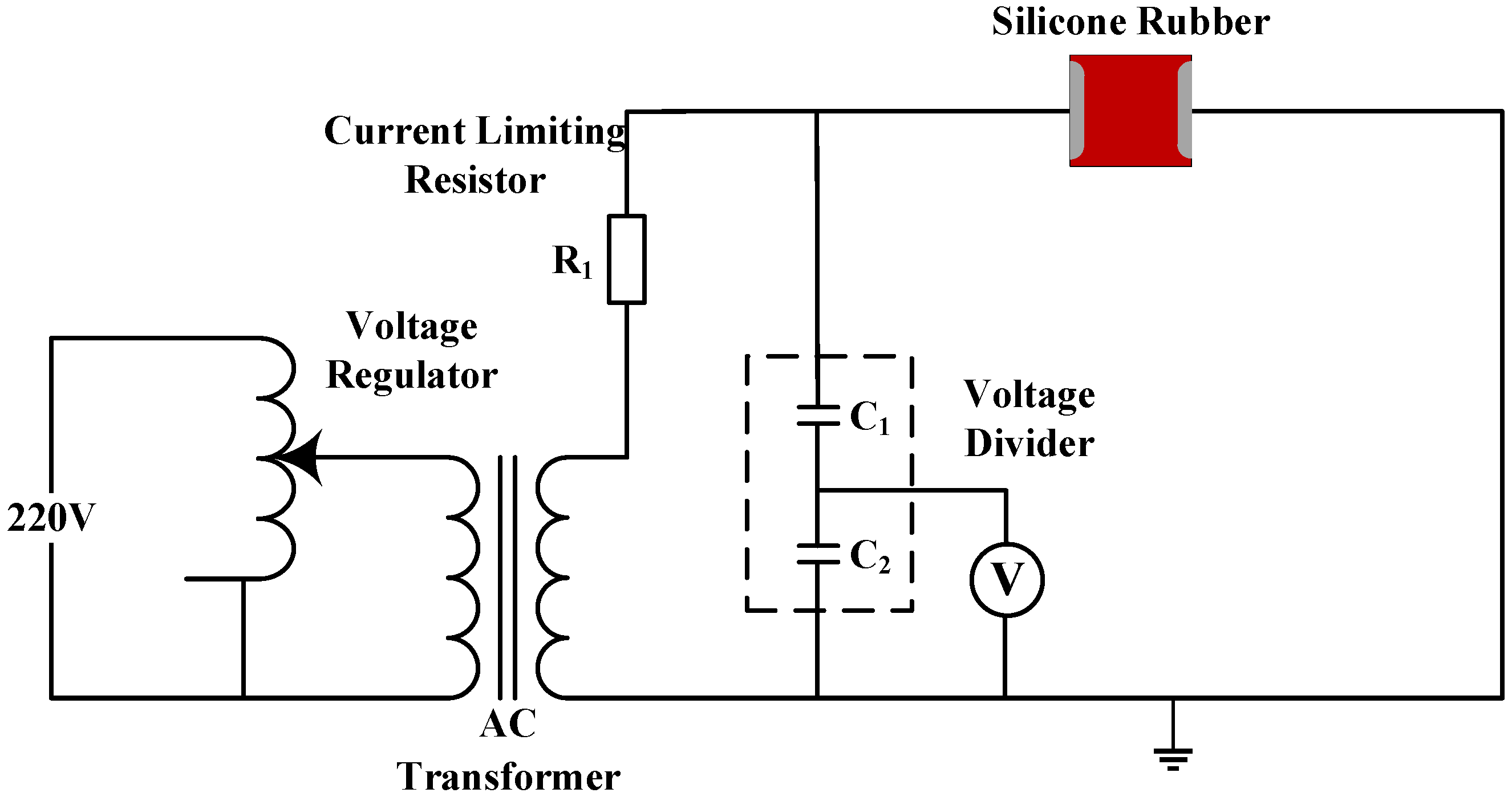

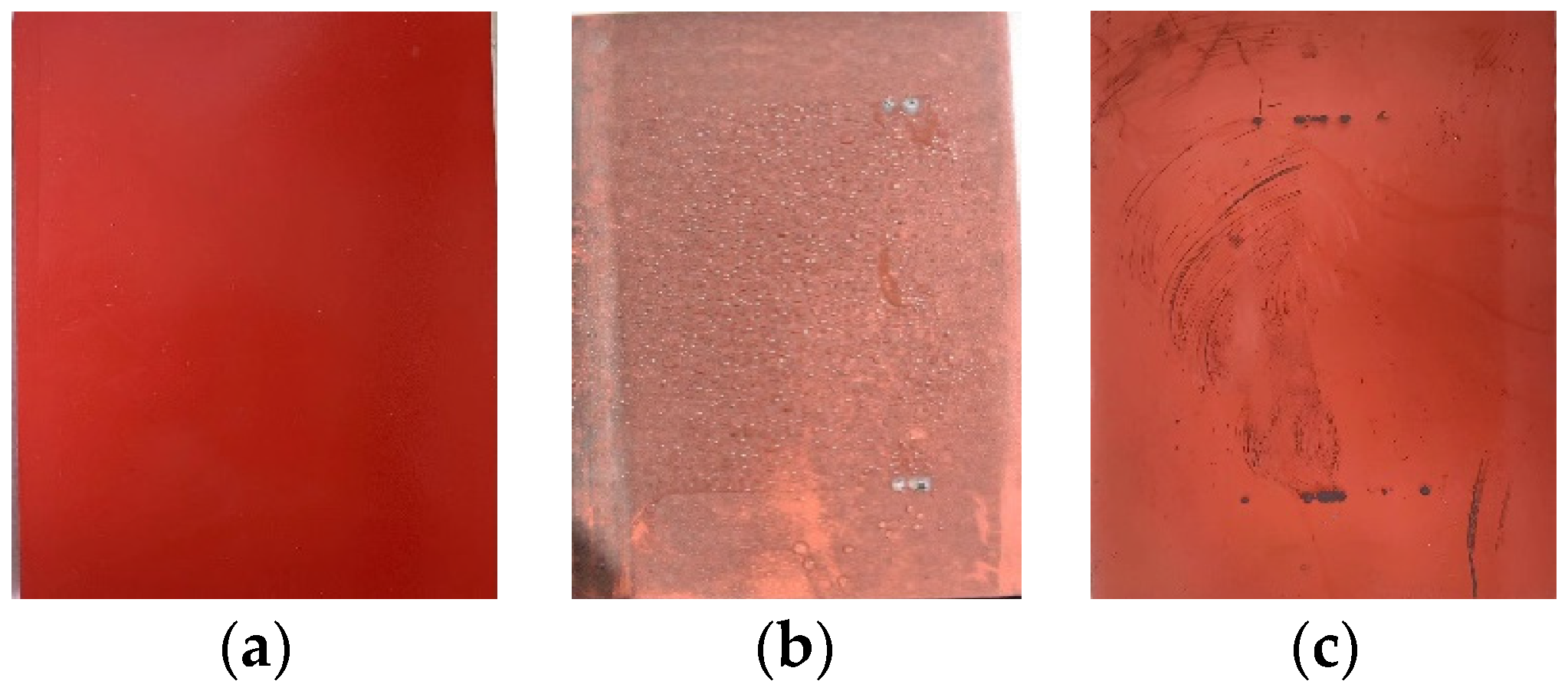
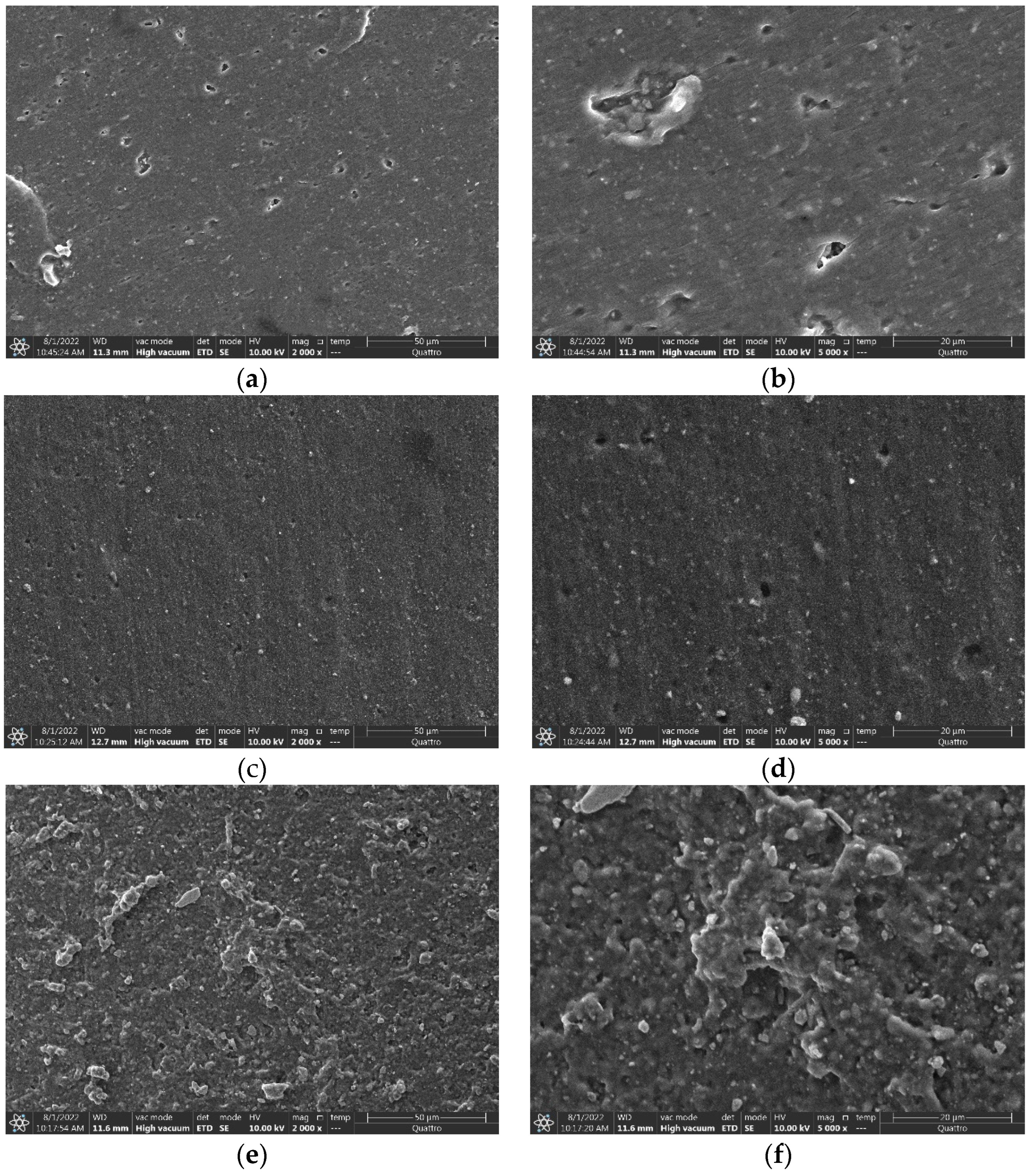

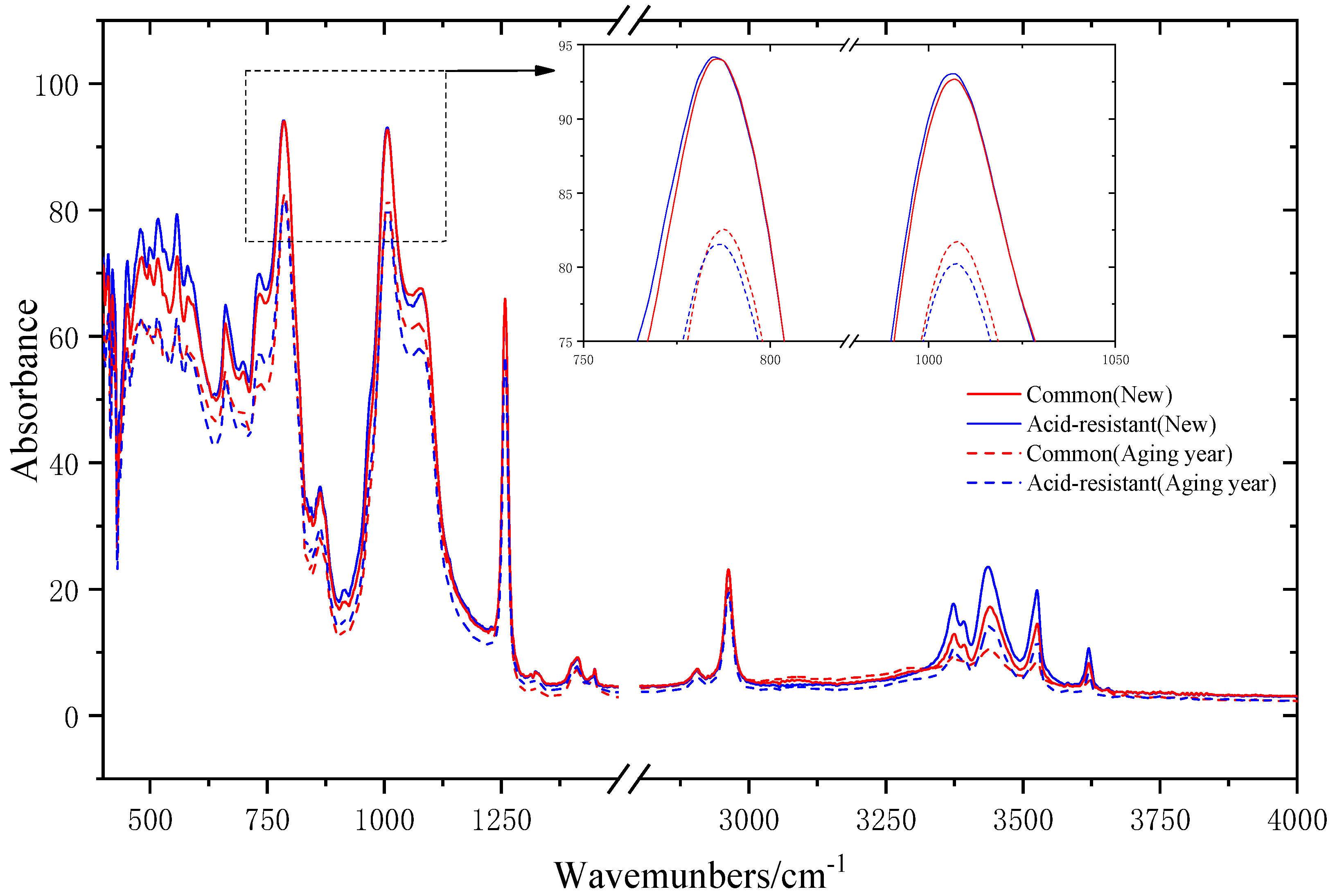
| Type | Aging Years (Year) | Average Dry Flashover Voltage (kV) | Relative Deviation |
|---|---|---|---|
| Common | 0 | 46.7 | 1.63% |
| 1 | 46.1 | 1.59% | |
| Acid-resistant | 0 | 50.3 | 1.37% |
| 1 | 49.9 | 0.85% |
| Type | Aging Years (Year) | with Dirt | after Cleaning | ||
|---|---|---|---|---|---|
| θAV (°) | HC Grading | θAV (°) | HC Grading | ||
| Common | 0 | / | / | 115.2 | 1 |
| 1 | 117.8 | 1 | 110.2 | 2 | |
| Acid-resistant | 0 | / | / | 131.1 | 1 |
| 1 | 134.9 | 1 | 126.2 | 1 | |
| Type | Aging Years (Year) | Average Pollution Flashover Voltage (kV) | Relative Deviation |
|---|---|---|---|
| Common | 0 | 20.2 | 2.52% |
| 1 | 16.2 | 4.90% | |
| Acid-resistant | 0 | 22.9 | 3.30% |
| 1 | 18.6 | 2.99% |
| Functional Groups | Wavenumbers (cm−1) |
|---|---|
| Si(CH3)3 | 800~700 |
| O−Si(CH3)2−O(Si−O) | 840~790 |
| Si−O−Si(Si−O) | 1100~1000 |
| Si−CH3(C−H) | 1270~1255 |
| CH3(C−H) | 2960 |
| O−H | 3700~3200 |
| Type | Aging Years (Year) | Relative Content of C (%) | Relative Content of O (%) | Relative Content of Si (%) |
|---|---|---|---|---|
| Common | 0 | 35% | 26% | 29% |
| 1 | 34% | 32% | 27% | |
| Acid-resistant | 0 | 36% | 28% | 29% |
| 1 | 35% | 33% | 28% |
| Type | Aging Years (Year) | Dielectric Loss Angle | Rate of Change |
|---|---|---|---|
| Common | 0 | 0.0393 | / |
| 1 | 0.0637 | +62.1% | |
| Acid-resistant | 0 | 0.0358 | / |
| 1 | 0.0427 | +19.3% |
Disclaimer/Publisher’s Note: The statements, opinions and data contained in all publications are solely those of the individual author(s) and contributor(s) and not of MDPI and/or the editor(s). MDPI and/or the editor(s) disclaim responsibility for any injury to people or property resulting from any ideas, methods, instructions or products referred to in the content. |
© 2023 by the authors. Licensee MDPI, Basel, Switzerland. This article is an open access article distributed under the terms and conditions of the Creative Commons Attribution (CC BY) license (https://creativecommons.org/licenses/by/4.0/).
Share and Cite
Zhang, Z.; Zhang, Z.; Yue, S.; Jiang, X.; Hu, J. Performance Characteristics of Silicone Rubber for Use in Acidic Environments. Polymers 2023, 15, 3598. https://doi.org/10.3390/polym15173598
Zhang Z, Zhang Z, Yue S, Jiang X, Hu J. Performance Characteristics of Silicone Rubber for Use in Acidic Environments. Polymers. 2023; 15(17):3598. https://doi.org/10.3390/polym15173598
Chicago/Turabian StyleZhang, Zhijin, Zhiqin Zhang, Song Yue, Xingliang Jiang, and Jianlin Hu. 2023. "Performance Characteristics of Silicone Rubber for Use in Acidic Environments" Polymers 15, no. 17: 3598. https://doi.org/10.3390/polym15173598
APA StyleZhang, Z., Zhang, Z., Yue, S., Jiang, X., & Hu, J. (2023). Performance Characteristics of Silicone Rubber for Use in Acidic Environments. Polymers, 15(17), 3598. https://doi.org/10.3390/polym15173598









